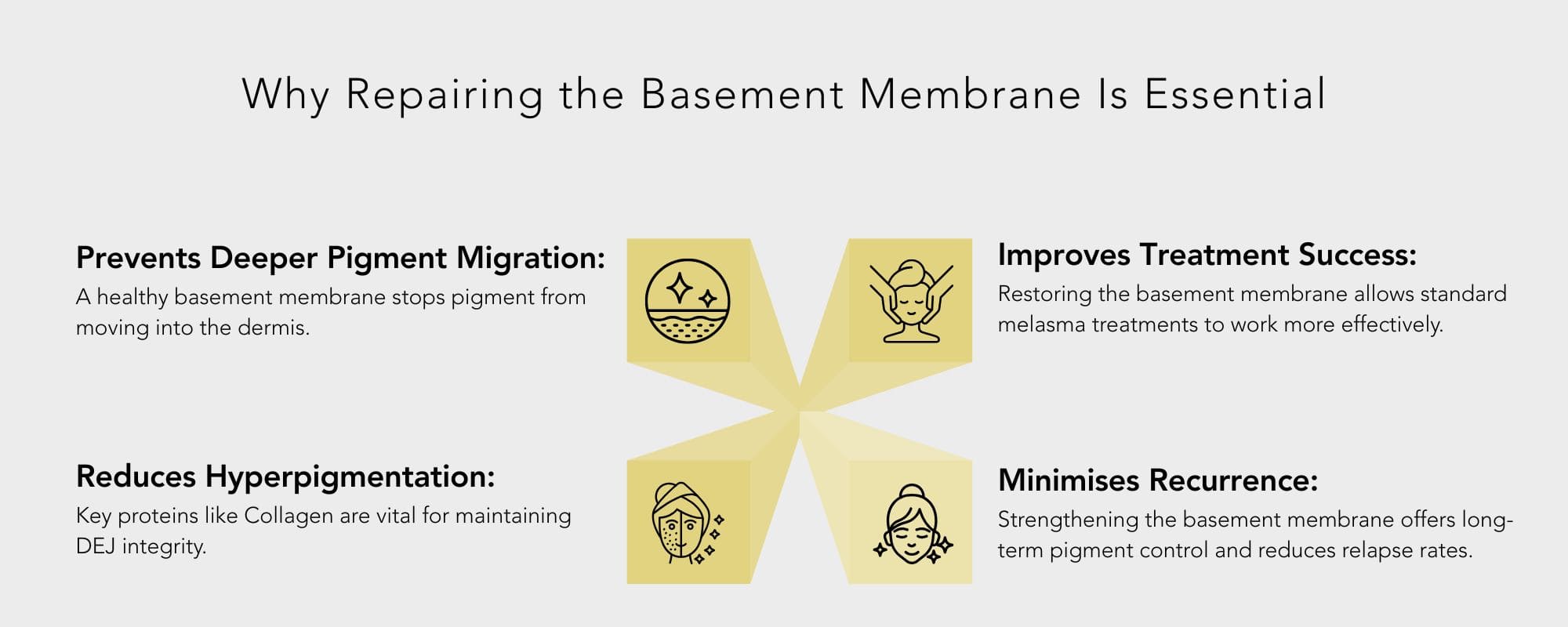

Melasma shows up when several different factors team up to over‑produce pigment in your skin. Even a little sun can "wake up" melanocytes (the cells that make colour), while hormone shifts—like those during pregnancy or from birth control—can push them into overdrive.
Treating melasma is never a one-and-done affair—its stubborn nature stems from multiple layers of complexity that must be addressed simultaneously. In the bullet points below, we'll explore each of these challenges so you can see why a broad, targeted approach is essential for lasting results.
When the basement membrane becomes damaged, melanocytes and pigment particles can penetrate deeper into the dermis, forming pendulous melanocytes. This dermal pigmentation is far more challenging to treat than superficial epidermal pigmentation.
Methylation acts like tiny switches on our DNA, quietly turning genes on or off without changing the genetic code itself. In melasma, these switches become stuck in the "on" position for pigment-making genes, causing melanocytes to produce excess pigment and flood the skin with colour. Sunlight can flip even more of these switches, deepening the tint. Still, treatments such as retinoic acid, niacinamide, and mineral-rich sunscreens work to reset them—soothing oxidative stress and gently coaxing those overactive switches back toward balance.
Slow bowel motility prolongs oestrogen recirculation and raises systemic inflammation—both of which can indirectly fuel hyperpigmentation.
Melasma isn't just about excess pigment — your blood vessels play a significant role, too. Understanding the vascular component helps explain why topical treatments alone may not be enough. Treatments that also target inflammation and blood vessel overgrowth can offer better, longer-lasting results. Here's how increased vascular activity contributes to stubborn pigmentation:
Sun exposure is one of the primary triggers of melasma, and it does more than darken the skin. UV rays can increase blood vessel activity in the skin, potentially worsening pigmentation. This happens in a few ways:
This is why daily sun protection is essential when treating melasma, especially when increased vascularity is a contributing factor.
Hormones play a significant role in the development of melasma, particularly in changes in blood vessels and increased pigmentation.
Emerging research suggests a connection between chronic pigmentation, such as melasma, gut imbalances, including leaky gut syndrome, and inflammation. Poor gut health can lead to increased systemic inflammation, contributing to hormonal imbalances and oxidative stress, which can exacerbate hyperpigmentation.
Probiotics, prebiotics, anti-inflammatory foods, and eliminating gut disruptors like gluten, dairy, and sugar may help reduce flare-ups and improve skin clarity over time.

Melasma's resilience reflects the many layers of our skin and body—from the skies above to the currents within, and calls for more than a single remedy. At Skin Renewal, we blend science and empathy, guiding you through a personalised plan that unites sun-smart habits, targeted treatments and holistic support. Together, we'll illuminate each challenge, layer by layer, transforming persistent patches into a canvas of confidence and allowing your true radiance to shine through.